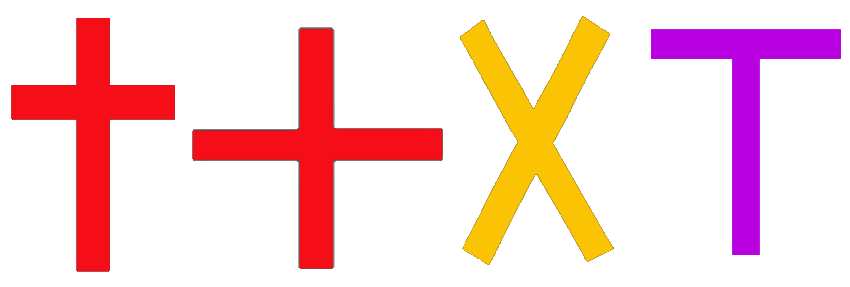
by George L. Marshall, Jr., PGC, ADC, 33°
Most of the myriad varieties of crosses which exist in art today can be considered as permutations or embellishments of four basic cruciform figures: the Latin Cross, the Greek Cross, the St. Andrew’s Cross, and the Tau Cross, which are pictured below in the order just stated:

The Latin Cross is surely the most widespread and best-known cross that we as Templars use. It is the badge of office for a Commander and Past Commander as well as the emblem used on the uniforms of Knights below those ranks, the only difference being that the Knight’s cross is a red cross with a silver border while that of a Commander or Past Commander is red with a gold border. The Latin Cross is also the symbol most commonly associated with variously symbolized health, fertility, life, immortality, the union of heaven and earth, spirit and matter, and the sun and the stars. It is sometimes referred to as the Western Cross to differentiate it from other cross designs favored in the east. The Latin Cross was typically used as the basic floor plan of medieval Western churches and cathedrals.
Another name for the Latin Cross is Crux Immissa. This simply means a crosswith a horizontal beam inserted at right-angles to the upright post. Immissa means tata which means "with a head".
In some Grand Jurisdictions, the Latin Cross with rays emanating from it is used. This form of Latin Cross is often referred to as the Passion Cross,  pictured at left. The added rays symbolize the power and majesty of the crucified and risen Christ and the victory he achieved over death. It is of interest to note that the Latin Cross or Passion Cross was not considered a typically Christian symbol until the seventh century. Before that time, the lamb and the fish were most commonly used.
pictured at left. The added rays symbolize the power and majesty of the crucified and risen Christ and the victory he achieved over death. It is of interest to note that the Latin Cross or Passion Cross was not considered a typically Christian symbol until the seventh century. Before that time, the lamb and the fish were most commonly used.
The next step up in the hierarchy of the Crosses of Templary would be the Templar Cross, which is a variant of the Greek Cross. Still other variants which we as Templars utilize are the Maltese Cross (Order of Malta) and the Cross Formée (Order of the Red Cross medal). The Templar Cross,  shown at left, is formed of four equilateral triangles whose apexes meet at a common center.
Another name for this cross is the Cross Formée Patée. This is the cross we use to designate Grand Commandery officers (red cross with gold border) and Past Grand Commanders (purple cross with gold border).
However, depending on the reference consulted, other cross forms (including that of Malta) are commonly referred to as the Templar Cross. One of the most common of these is depicted at right,
shown at left, is formed of four equilateral triangles whose apexes meet at a common center.
Another name for this cross is the Cross Formée Patée. This is the cross we use to designate Grand Commandery officers (red cross with gold border) and Past Grand Commanders (purple cross with gold border).
However, depending on the reference consulted, other cross forms (including that of Malta) are commonly referred to as the Templar Cross. One of the most common of these is depicted at right, 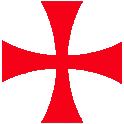 the Cross Patée, which was sometimes used by the Crusader order of Teutonic Knights and was also sometimes associated with the Crusader order of Knights Templar, though as with the Teutonic Knights, it was not used consistently. The Templars did adopt a red cross on their white robes in 1147, but there was no specific style designated, and different Templars used different versions of the cross. The pattée was by no means their official symbol. From the evidence of document seals, the Cross Formée and Cross Pattée with a variant form in the Pattée Formée were used in the 12th and 13th centuries. Some variations of the Cross Formée/Pattée had concave ends to the arms, moving the design toward the eight pointed cross which would evolve into the Maltese cross. In the mid 1500s, when the Knights were at Malta, the familiar design now known as the Maltese Cross made its appearance. The true Maltese cross has a very strict definition: “A cross made from four straight lined pointed arrowheads, meeting at their points, with the ends of the arms consisting of indented ‘V’s.” Simply put, the ends are not flat. Thus, the Maltese Cross, shown here,
the Cross Patée, which was sometimes used by the Crusader order of Teutonic Knights and was also sometimes associated with the Crusader order of Knights Templar, though as with the Teutonic Knights, it was not used consistently. The Templars did adopt a red cross on their white robes in 1147, but there was no specific style designated, and different Templars used different versions of the cross. The pattée was by no means their official symbol. From the evidence of document seals, the Cross Formée and Cross Pattée with a variant form in the Pattée Formée were used in the 12th and 13th centuries. Some variations of the Cross Formée/Pattée had concave ends to the arms, moving the design toward the eight pointed cross which would evolve into the Maltese cross. In the mid 1500s, when the Knights were at Malta, the familiar design now known as the Maltese Cross made its appearance. The true Maltese cross has a very strict definition: “A cross made from four straight lined pointed arrowheads, meeting at their points, with the ends of the arms consisting of indented ‘V’s.” Simply put, the ends are not flat. Thus, the Maltese Cross, shown here, 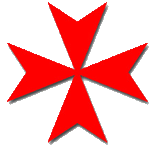 should not be confused with the Templar Cross, which is in the style of the Cross Patée or the Cross Formée Patée.
should not be confused with the Templar Cross, which is in the style of the Cross Patée or the Cross Formée Patée.
Another important cross of Templary is the Patriarchal Cross. This Cross, when in purple enamel and edged with gold, is the insignia of all officers of the Grand Encampment below the Grand Master.
It is the Latin Cross with an extra horizontal beam appended. Other names include Archiepiscopal Cross, Archbishop’s Cross, or Metropolitan Cross in reference to the archbishop’s ecclesiastical authority for a diocese.
 Several explanations exist for the extra beam, and the most popular is that the upper beam, also seen on the Russian and Eastern Orthodox crosses, represents the sign bearing Pontius
Several explanations exist for the extra beam, and the most popular is that the upper beam, also seen on the Russian and Eastern Orthodox crosses, represents the sign bearing Pontius
Pilate’s inscription "Jesus of Nazareth, King of the Jews." This sign is known in Latin as titulus cruces and therefore this cruciform is sometimes called the Titulus Cross.
Another explanation is that the first beam represents the death of Jesus Christ and the second beam His resurrection.
A third view is that the first beam symbolizes secular power and the second beam the ecclesiastic power of Byzantine emperors. In the 9th century, this cross was a political symbol used by Byzantine clerks and missionaries.
"Patriarch" is the title of a bishop who is second to the pope and has the highest rank in the hierarchy of his jurisdiction. This particular cross form was part of the coat-of-arms of the Patriarch of Jerusalem, who granted its use to the Knights Templar. It is thus a fitting symbol of office in our Grand Encampment for the Department Commanders who represent the Grand Master in their respective departments and those officers who are subordinate to him in the Grand Encampment line.
The Duke of Lorraine, Godfrey de Boullion, used the cross shown below 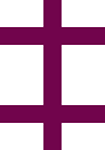 for his standard when he took part in the capture of Jerusalem. The cross was then passed on to his successors as heraldic arms and became known as the Cross of Lorraine. The Cross of Lorraine originates from the Patriarchal Cross and confusingly, either name is used for either cross form. The Cross of Lorraine, however, differs from the patriarchal cross. It has two horizontal bars of equal length placed with the lower bar located close to the bottom and the upper bar close to the top. On the true patriarchal cross, on the other hand, both bars are near the top, and the upper is noticeably smaller than the other. The Grand Encampment patriarchal cross has the two beams more separated and so resembles, at first glance, the Cross of Lorraine.
for his standard when he took part in the capture of Jerusalem. The cross was then passed on to his successors as heraldic arms and became known as the Cross of Lorraine. The Cross of Lorraine originates from the Patriarchal Cross and confusingly, either name is used for either cross form. The Cross of Lorraine, however, differs from the patriarchal cross. It has two horizontal bars of equal length placed with the lower bar located close to the bottom and the upper bar close to the top. On the true patriarchal cross, on the other hand, both bars are near the top, and the upper is noticeably smaller than the other. The Grand Encampment patriarchal cross has the two beams more separated and so resembles, at first glance, the Cross of Lorraine.
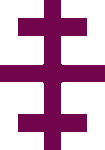 The cross reserved for the insignia of the supreme leadership of our Order is the Cross of Salem, sometimes referred to as the Papal Cross, because it is borne by the Pope on special ceremonial occasions. The upright beam is crossed by three horizontal beams, the upper and lower shorter than the middle one. When in purple enamel, and edged with gold, it is the insignia of the Grand Master and of Past Grand Masters. It is not only the insignia of the Grand Master and Past Grand Masters of the Grand Encampment of Knights Templar of the United States, but the same cross, placed on a slant, is the insignia of the Sovereign Grand Commander of the Supreme Council of the Ancient and Accepted Scottish Rite. The modern Papal Cross differs somewhat from this, in that the three horizontal beams increase in size going downward from the top.
The cross reserved for the insignia of the supreme leadership of our Order is the Cross of Salem, sometimes referred to as the Papal Cross, because it is borne by the Pope on special ceremonial occasions. The upright beam is crossed by three horizontal beams, the upper and lower shorter than the middle one. When in purple enamel, and edged with gold, it is the insignia of the Grand Master and of Past Grand Masters. It is not only the insignia of the Grand Master and Past Grand Masters of the Grand Encampment of Knights Templar of the United States, but the same cross, placed on a slant, is the insignia of the Sovereign Grand Commander of the Supreme Council of the Ancient and Accepted Scottish Rite. The modern Papal Cross differs somewhat from this, in that the three horizontal beams increase in size going downward from the top.
Like the patriarchal cross, several symbolic interpretations can be given for this cross:
Thus, like the Papal Cross, Freemasonry’s use of the three-barred Salem Cross signifies the highest rank as well as the highest responsibility of the wearer.
References and Sources
1. "Banners of the Order of The Temple", http://www.sacred-texts.com/mas/shib
2. "The Papal Cross also known as the Salem Cross and the Maronite Cross", http://www.seiyaku.com/customs/crosses/papal.html
3. Runciman, Steven, A History of the Crusades, Vols I-III, Cambridge University Press, 1999
4. "The Latin Cross", http://www.seiyaku.com/customs/crosses/latin.html
5. "Latin Cross (Christian Symbol)", http://www.britannica.com/EBchecked/topic/331836/Latin-cross
6. "Christian cross", The Free Dictionary, http://encyclopedia2.thefreedictionary.com/Latin+Cross
7. "History of the Maltese Cross, as used by the Order of St. John of Jerusalem", Rev. Dr. Michael Foster, http://www.orderstjohn.org/osj/cross.htm
8. "The Maltese Cross: What’s the Deal?", http://pells.blogspot.com/2005/04/maltese-cross-whats-deal.html
9. "The Maltese Cross - a sinister design?", http://www.netpages.free-online.co.uk/gms/sinister.htm
10. "Maltese Cross", http://mathworld.wolfram.com/MalteseCross.html
11. "The Patriarchal Cross", http://www.seiyaku.com/customs/crosses/patriarchal.html
12. "Patriarchal cross", http://www.absoluteastronomy.com/topics/Patriarchal_cross
13. "The Cross of Lorraine", http://seiyaku.com/customs/crosses/lorraine.html
14. "Patriarchal Cross", http://en.wikipedia.org/wiki/Patriarchal_cross
15. "The History of Crosses", http://www.crosses.org/history.htm
16. Read, Piers Paul, The Templars, St. Martin’s Press, 1999
17. Seward, Desmond, The Monks of War, Penguin Books, 1995.
Sir Knight Marshall is a Past Grand Commander and Past Grand High Priest of Alabama and serves as an Aide-de-Camp to the Grand Master of the Grand Encampment as well as General Grand Custodian of the Work for the General Grand Chapter, Royal Arch Masons, International. He is a Knight Commander of the Temple of the Grand Encampment and has published articles in the Royal Arch Mason, Knight Templar, and Philalethes magazines. He resides at 161 Anna Kathryn Drive, Gurley, AL 35748 and can be reached at: geomarsh@yahoo.com